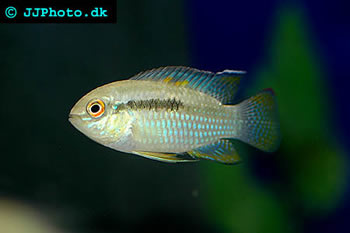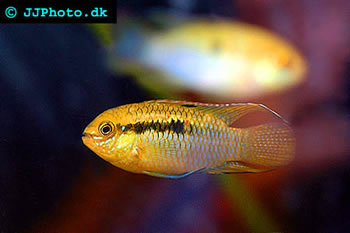Flag Acara, Laetacara Curviceps
By: Turkey151General Flag Acara facts
A member of the Cichlid family, Laetacara Curviceps is also know as the Curviceps, the Flag Acara, and the Flag Cichlid. Native to the Amazon River Basin and the lower regions of amazonian tributaries, The Flag Acara can be found in calmer, slow-moving waters. They will appreciate surroundings similar to their natural habitat which would include lots of vegetation, roots, driftwood, and flat rocks for spawning. This Cichlid is more of a free swimmer and doesn't require rocky caves for hiding as some Cichlids do, but it does require a good amount of swimming space. Thankfully, unlike some other Cichlids, this species will not up root plants. This Flag Acara is a hardy specimen, and males will grow to about 4" / 10 cm and females up to 3.5" / 8-8,5 cm
Flag Acara Care
The Flag Acara will do well in groups or pairs, this fish tends to pair young and will often pair for life. A tank of 20 gallons or more will do fine for this species but, as with most Cichlids, good filtration and scheduled water changes are a must. Preferred water parameters are pH - 5.5 - 7.5, Temp - 72 - 80 F dH - 5 - 12. The Flag Acara appreciates soft acidic water, also known as black water conditions. It can however be made to tolerate a variety of conditions but is very sensitive to poor water conditions and a neglectful water change schedule. It is very important to do weekly water changes of up to 30% to keep this fish healthy, happy, and showing its best colors. The dietary habits of this species are some-what debatable. The Flag Acara is omnivorous, and will accept flakes and pellets. However, this fish will do better on a diet that is supplemented by live foods which may include crustaceans, insects, aquatic insects, worms, and or many types of insect larvae. Feeding the Flag Acara more live foods will also help maintain health and color.Flag Acara Tank Mates
|
Breeding Flag Acara
Sexing the Flag Acara is fairly straight forward, The males tend to have elongated dorsal and anal fins, and at full length also tend to be longer overall than the female of this species. The Flag Acara tends to pair up very young, sometimes at a length as small as 1.5" and will pair for life, swimming along side each other. A pH of 6.0 - 6.8 and water hardness of 1-6 dH is favorable for inducing spawning. Feeding live foods such as insect larvae and crustaceans will also help, and frequent water changes are a must. Overall inducing breeding for the Flag Acara is not difficult.The Flag Acara is a open substrate spawner. It will almost always lay its eggs on a pre-cleaned flat surface such as a stone. After a few short days the eggs will hatch and become wigglers. The wigglers will than feed off of their yolk sacs until they, still very small, will become free swimming. Normally they will accept newborn brine shrimp as a first food but can also be fed liquid fry food. The Flag Acara are dedicated parents and both the male and female will protect the eggs, wigglers and fry. Though dedicated, parents will often fail on the first try, panicking and eating their own eggs. This can be avoided by removing the eggs if caught in time but generally, the second try is much more successful for this species. Its important to note that aquarium bred Flag Acara are often less colorful than wild caught fish of the same species.
Small, colorful, and with a great temperment the Flag Acara is a wonderful fish for any medium to large peaceful community tank.
Other Dwarf Cichlid Articles
Apistogramma panduro - Keeping and breeding Apistogramma panduro
Apistogramma sp. Maulbrüter - The Mouthbrooding Apistogramma - This fish is a delayed mouthbrooder, mouthbrooding the fry rather than the eggs.
Apistogrammas My Way - Setting up the tank. The spawning. Reverse osmosis water. New species.
Breeding Apistogramma njesseni - Breeding Apistogramma njesseni
Breeding the African Butterfly Cichlid, Anomalochromis thomasi - This small riverine cichlid from West Africa is easy to breed and raise, even in a community setting.
Dicrossus filamentosa - Information about how to keep and breed checkerboard cichlids.
Dwarf Crenicichla - Information about Dwarf Crenicichla
Dwarf Pike Cichlids - how to keep and breed dwarf pike cichlids
Jewel cichlid - Information about Jewel cichlid
Jeweled cichlids - Information about Jeweled cichlids
Keeping And Breeding Microgeophagus altispinosa (The Bolivian Ram) - The Bolivian Ram is easy to breed.
Keeping and Breeding Taeniacara candidi - Information about how to keep this species in aquariums.
Pelvicachromis taeniatus "Nigeria green" - A guide to keeping and breeding this fancy krib.
The Genus Apistogramma - Information about how to keep and breed apistogramma species in aquariums.


